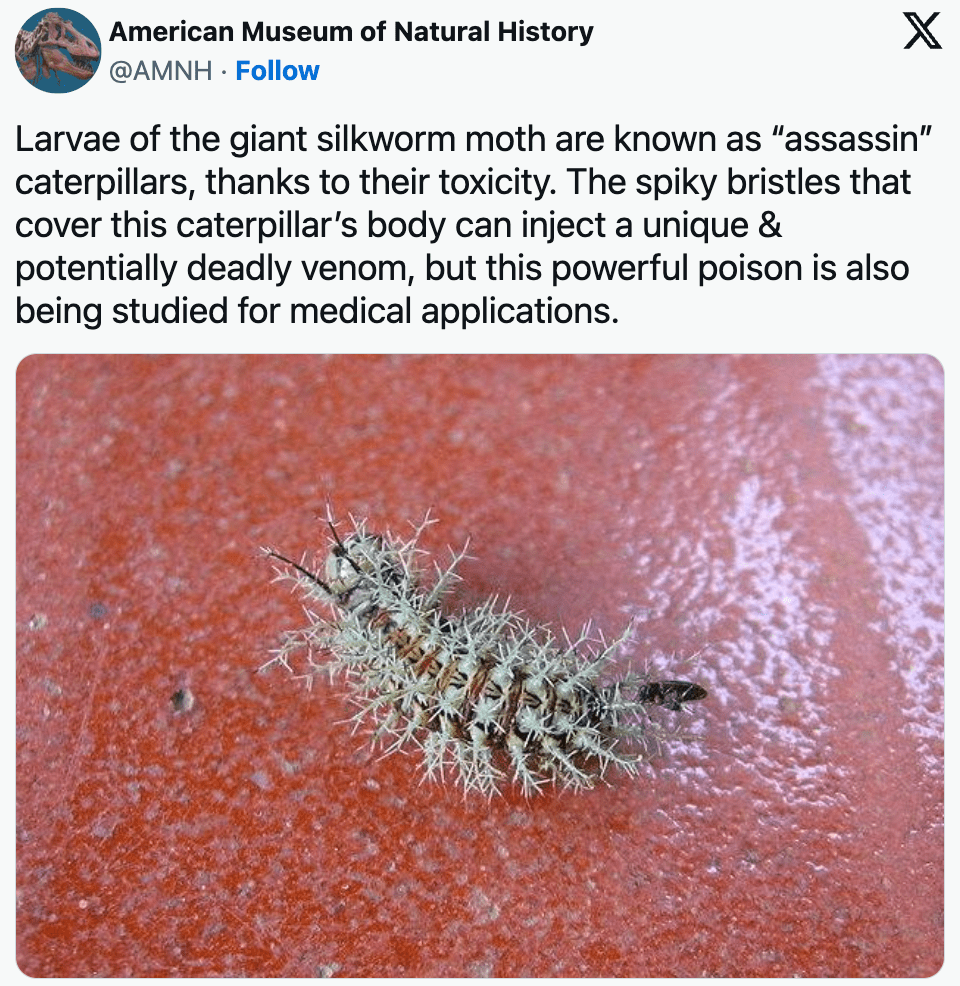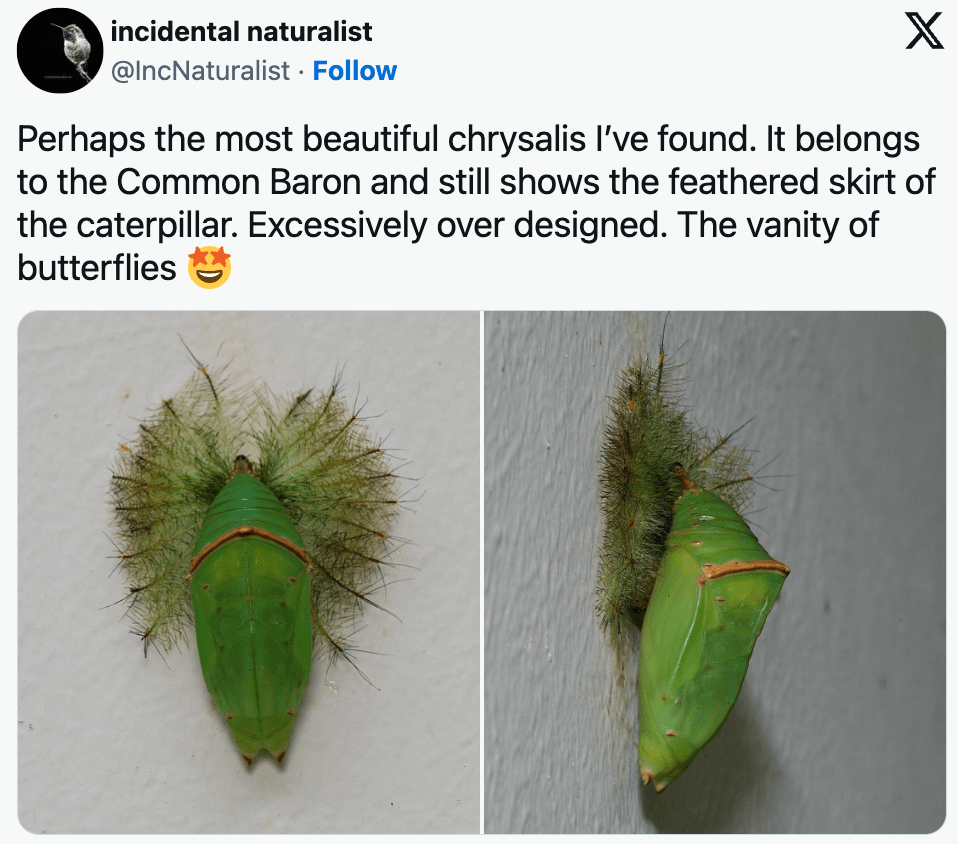Have you ever been surprised by a twig that starts moving, only to discover it’s a peaceful stick insect out for an afternoon stroll? Or maybe you’ve marveled at a pink critter that looks like a petal, but is actually a flower mantis disguised as it hides from hummingbirds and other prey.
These creatures, along with many others, play the ultimate game of hide-and-seek. They blend so well into their surroundings that they go unnoticed until they want to be seen. Sometimes, this impressive mimicry and deception is used to outwit prey, while in other cases, it’s for protection against predators, just like some caterpillars.

Let’s delve into the fascinating world of these secretive creatures and explore the amazing tricks that nature has bestowed upon them.
The Art of Camouflage: The Common Baron Caterpillar
One creature that uses camouflage for protection is the common baron caterpillar. It disguises itself, hoping to safely complete its lifelong quest to transform into a medium-sized brown or green butterfly.
Take a closer look at the clip of the green mango leaf above. Can you spot anything peculiar? Keep watching.

Although it may seem like a simple green leaf, it’s actually a baron caterpillar stretching across the middle vein. It blends in almost perfectly with its environment.
The common baron caterpillar, scientifically known as Euthalia aconthea, is native to India and Southeast Asia. People on the internet were impressed with this crafty caterpillar’s ability to camouflage itself. One user remarked, “Nature’s perfect harmony! When a caterpillar and a leaf become a work of art in symmetry.” Another user exclaimed, “This is the best camouflage I’ve ever seen!”
However, not everyone found it cool. One user admitted that the caterpillar’s fern-like design was more creepy than fascinating. They wrote, “Things like this are what my nightmares are made of. Nevertheless, it’s still very fascinating to observe.”
A Survival Strategy: The Journey of the Common Baron Caterpillar

The eggs of the common baron, which are laid by nymphalid butterflies, resemble spiky green balls found on the underside of a leaf, often attached to mango trees, their favorite fruit.
As the larvae grow, branching spines emerge from their sides, aiding them in crawling across the leaves. The leaves not only serve as a landing pad for the caterpillar to feast on but also provide a place where they can blend in, making them nearly invisible to birds.
These feathery-like green caterpillars have a palette for mangoes and cashew nuts. They use camouflage as a survival strategy, increasing their chances of reaching metamorphosis, where they develop into butterflies and eventually have offspring of their own.
During this developmental stage, lasting several weeks, the fuzzy caterpillar leads mostly a solitary life, evading hungry predators with its masterful disguise.
The next phase is the chrysalis, during which the caterpillar seeks refuge in a bright green leaf-like pod. It’s a magical time! Soon after, it emerges as a nymphalid butterfly with less impressive camouflage, sporting either brown or green wings depending on its gender.
Other Brilliantly Camouflaged Critters
The common baron caterpillar is not the only creature that has developed a unique safety strategy. Let’s explore a few others:
Cartoon Caterpillar: Spicebush Swallowtail Caterpillar
The adorable, cartoon-like spicebush swallowtail caterpillar is a favorite snack for dragonflies, birds, and spiders. When these cute little creatures feel threatened, they exude red drops of a foul-smelling liquid. Found throughout North America, the spicebush caterpillar transforms into a beautiful black butterfly, with white spots on the top of its wings and orange on the underside.
Snakehead Caterpillar: Great Orange Tip Caterpillar
The great orange tip caterpillar, scientifically known as Hebomoia glaucippe, gained popularity due to its ability to mimic a mildly poisonous snake. When this little creature feels threatened, it raises its head in a way that imitates a snake ready to strike.
After its transformation, it becomes a butterfly with beautiful white wings adorned with orange and black tips, reminiscent of the markings of a monarch.
Assassin Caterpillar: South America’s Giant Silkworm
South America’s giant silkworm has developed a more lethal approach to self-defense. Known as the “assassin caterpillar,” this creature is covered in hollow spiny hairs that any predator will soon regret touching. Filled with a highly toxic venom, this caterpillar injects venom through these needles, resulting in internal hemorrhaging and hemolysis. With its lethal toxins, this venomous caterpillar can even kill an adult human and is responsible for several deaths in South America every year. It transforms into a moth when it sprouts its wings.
Nature is truly magical, and it has endowed some of the tiniest creatures with incredible survival abilities. While some of these evolutionary traits can be deadly, others are simply fascinating to observe, like the adorable spicebush swallowtail!
What do you think of these incredible stories from nature? Please share this article with others who may appreciate it!





